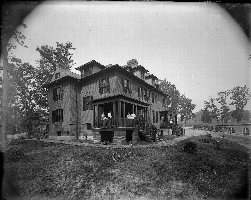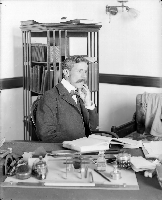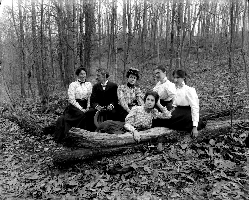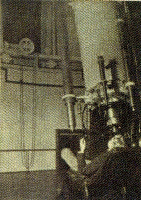

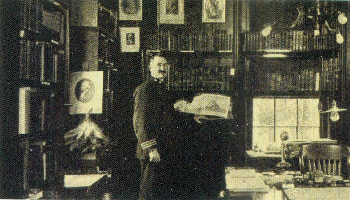

A complete history of T.J.J. See would be long and involved. This page does not try to give a complete portrait of his career at the USNO, and certainly not his experiences at other institutions. It just serves to collect some information related to his double star work while at the Naval Observatory. A complete history of See is certainly warranted. That being unavailable, this short emissif will have to do.
With his appointment at the USNO he wrote in Astronomische Nachrichten (141, 207; 1896) "It is not probable that I shall again engage in the systematic discovery and measurement of double stars." This proved almost true as his previous, very productive, output almost came to a halt. His work at the USNO consisted primarily of measurements of the diameters of solar system objects (planets and their major satellites), and measurements of their positions for celestial mechanics (for example the orbit of Enceladus), as well as the parallax determinations of Eros. He observed with the transit circle as well as the 26".
The double star totals for See given on the previous list reflect his output while in the See, Skinner, Brown, et al. collaboration during his tenure at the USNO from December 1899 to September 1902. This might have proved to be a fruitful collaboration were it not for See's great capacity for getting into difficult situations. At the time, the 26 inch was still one of the largest telescopes in the world. With the 1873 lens now in a more robust mount built by the Warner & Swasey and a cadre of observers, the future once more looked bright for See. He published a series of single measurement papers regarding fast moving or astrophysically interesting systems (Astronomische Nachrichten, 150, 327; 1899, 152, 73, 75; 1899, 152, 179; 1900, and 153, 99; 1900). He also assisted then director of the USNO, Stimson Brown, in the preparation of his first double star paper (Astronomische Nachrichten, 150, 329; 1900), and one might infer that he forsaw a bright future for See. He and Brown worked together observing many nights one might imagine them discussing their future and the future of the USNO. As discussed elsewhere, Brown favored keeping the USNO under Navy control but with a civilian in charge whereas other astronomers, notably Newcomb and Holden, wanted to see the ``N'' removed, and the USNO would become a part of the Commerce Department.
However, this turned out to be a poor topic of conversation. Around this time See became involved in a movement by the civilian astronomers at USNO to administer the Observatory without navy oversight. This eventually resulted in many detachments, among them, Brown, See and Updegraff which went to the Naval Academy. Brown also went to the Naval Academy in 1901 where he was named head of the mathematics department where he authored many mathematical texts. The departure of See and Brown was rapid and the majority of their measures double star measures were not published until 1911 as part of the USNO Second Series. Shortly thereafter, See went to the USNO facility for the Pacific Fleet at Mare Island, in San Francisco Harbor. Updegraff and See's paths crossed again at Mare Island when Updegraff came to the Mare Island Hospital from Prescott, Arizona with his family in 1938 with an illness which turned out to be pancreatic cancer. It was while at the USNO that See wrote his rather inflamatory note regarding Moulton's work in the Astronomical Journal (20, 56; 1899) and was subsequently banned from further publication in that journal. Further details regarding See can possibly be gleaned from W.L. Webb's book, A Brief Biography and Popular Account of the Unparallelled Discoveries of T.J.J. See (QB 36 .S4 W4). However, it has been alleged that this book was written by See himself.
For more information on this period, see Steve Dick's history, Sky and Ocean Joined.
While at Mare Island, isolated and alone, See did a little more work in binary stars. However, in this case his work was in the calculation of orbits not their observation (MNRAS, 68, 192, 185, 198, 201, 565; 1908). Most of his work continued to get more eccentric as he worked on his theory of the Aether and one might imagine him feeling marginalized.




See's story does not end here, however.
In 1997 Charles Worley added 3406 new doubles to the WDS from the Hipparcos
satellite. While most of these were errors of Hipparcos not checking the
literature (i.e., the WDS) closely enough, more have been removed since 2000
due to subsequent identification and checking. One which was recently examined
was the star known as HDS3147. Hipparcos measured the binary at 303.0 deg and
0.226". On scouring old literature it was determined that this double was
measured and in Burnham's Double Star (BDS) Catalogue but, apparently based on
work by Cogshall, who saw it as single, was left out of Aitken's Double Star
(ADS) Catalogue and all binary star catalogs since. The pair was measured by
that curious character of yore, T.J.J. See, with the 24" of Lowell while he
was on his Lowell Observatory: Mexico expedition. In two measures See determined
a position angle of 308.3 and a separation of 0.2". Seeing a dm ~ 1.8 pair at
the resolution limit of the telescope was quite an accomplishment. The remarkable
agreement in the other parameters is also quite striking. His announcement of
it in the AJ, two years before he was effectively banned from that as a publication
venue, mentioned that it needed monitoring. Ninety-three and a half years later,
we're finally getting around to it. The designation of the pair has been changed
to SEE 469.
